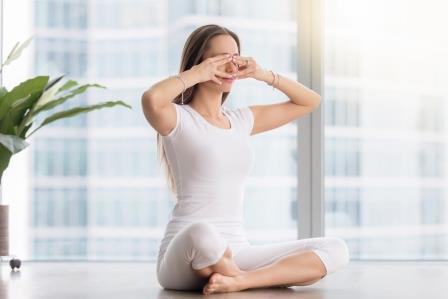Psychic Blog
Pranayama
17 Jan 2023

Lots of people find January & February to be difficult months. It is cold, and we often get snow; the sky can be grey, and the excitement of Christmas and social events have passed. This year, the energy crisis and economic difficulties may add to the woes.
But there are things that you can do – in the form of breathing exercises – that are simple and effective at reducing stress and increasing well-being – and they are free!
Pranayama
In Ayurvedic Healing, breathing exercises are called Pranayama. There are four exercises, each with a slightly different technique and health outcome.
Anuloma Viloma (Alternate Nostril Breathing)
Start by lifting your right hand to your nose. Exhale, and then use your right thumb to close your right nostril. Inhale deeply (through your left nostril), and then; close your left nostril with your ring finger whilst releasing your thumb from the right nostril; so you can exhale through that side. Inhale through the right nostril; before closing with the thumb again, open the left nostril and exhale through that side – now you have completed one full cycle.
Eventually, you should be able to complete 30 full cycles – but of course, start small and work up to this.
Benefit: Studies suggest that with regular practice, this breathing technique can help to lower blood pressure and also strengthen lung capacity. Holistically it improves mental clarity, perception and concentration. It’s particularly useful when you need to sweep away negative thoughts.
Bhastrika (Bellow Breath)
Bhastrika is a form of deep breathing (through the nose). The idea is – to squeeze as much air out of your lungs as possible as you breathe out; so that you may take a full breath in – often, we breathe shallower than we realise.
When you first start, do short bursts of deep breathing, with intervals of 2 minutes of breathing normally; this should stop you from feeling dizzy. Over time you can build up 20 deep breaths.
Benefit: Bellow Breath can help to release feelings of negativity and anger and can aid in coping with grief and depressive feelings.
Brahmari (Bee Breath)
First, you need to get into position: Sit down. Lift both of your arms, placing a thumb over your ears. Your index fingers cover your third eye, leaving your other fingers to cover your eyes.
Now, breath in deeply and as you breathe out – you hum like a bee!
Start with just a few, and over time you should be able to build up to 15 repetitions.
Benefit: This exercise helps to rest the eyes and soothe the mind, bringing closure to racing thoughts. It also works on the endocrine system, which helps regulate our hormones, stress levels and mood.
Kapalabhati (Skull-Shining Breath)
You sit down for this exercise – albeit at the edge of a chair. Take a deep breath in and out, then continue to inhale/exhale – but in a forceful manner and in rapid succession. The emphasis in this exercise is on exhaling.
Again, start slowly – building to 20 exhales, then a break. Eventually, you should be able to do 100 in around a minute.
Benefit: This is a great way to start a meditation; it can aid your concentration and slow and quiet the mind. It helps the respiratory system and encourages fresh blood to nourish your organs.
*Some breathing exercises are not recommended; for those that are pregnant, if you have high blood pressure, are menstruating, or are recovering from illness, particularly anything heart-related. As with any new health/exercise regime – consult your GP for advice.
TweetBrowse Our Blog
Categories
- Blog Home
- Angels
- Astrology
- Book Reviews
- Celebrity
- Crystals
- General
- Love
- Mediumship
- Paranormal
- Readers
- Seasons
- Special-Offer
- Spirituality
- Superstitions
- The Psychic Gift
- Wellbeing